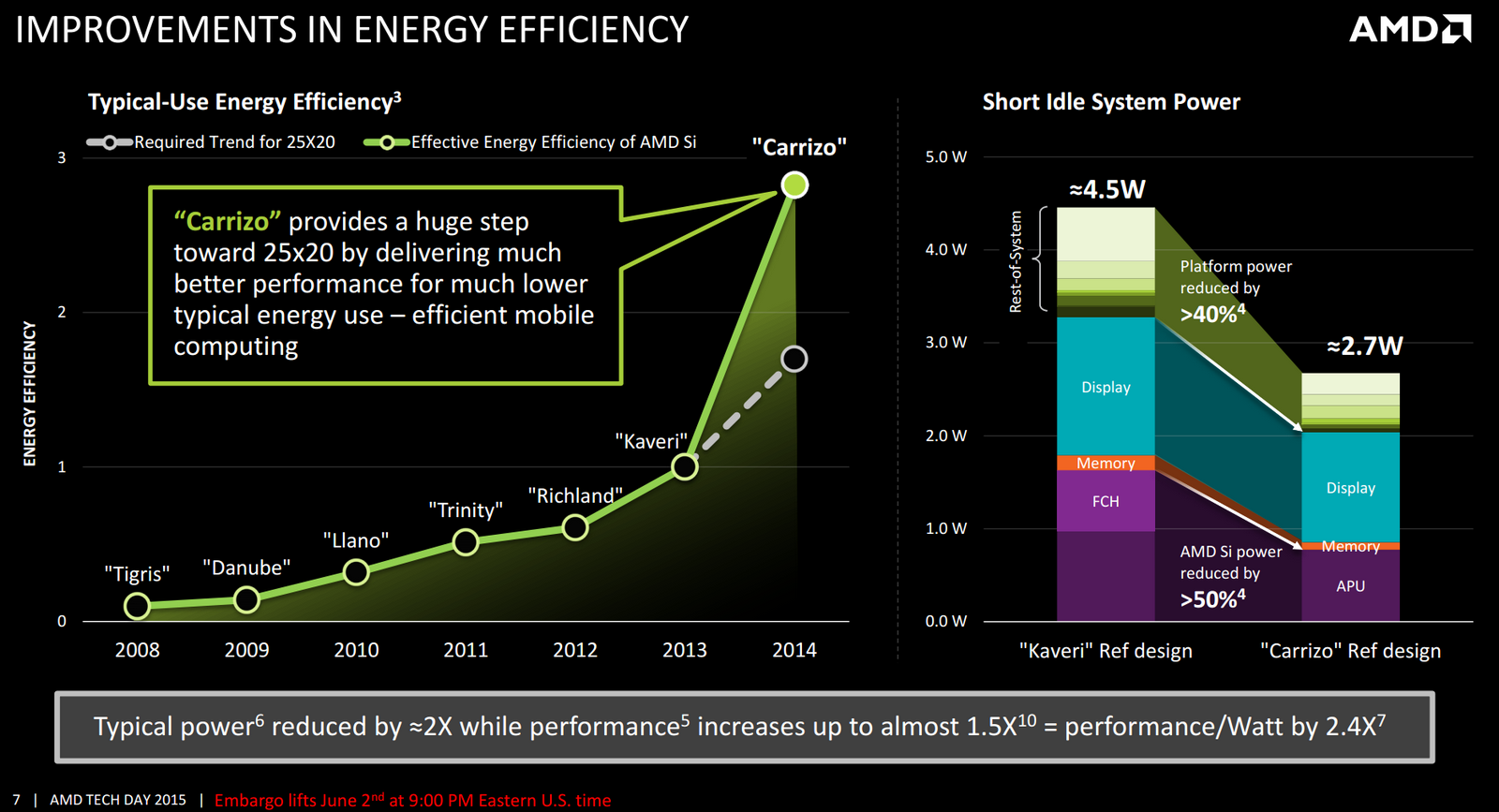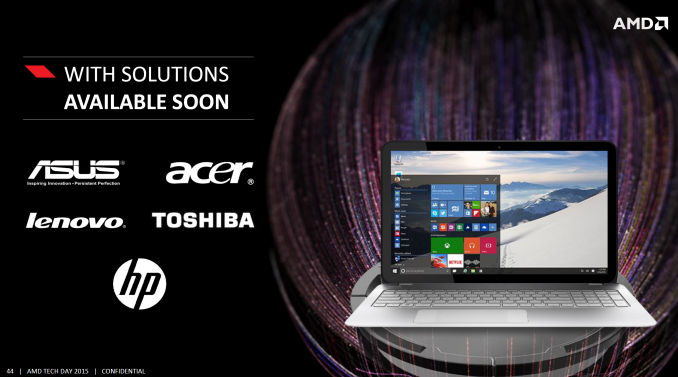Who Controls the User Experience? AMD’s Carrizo Thoroughly Tested
by Ian Cutress on February 4, 2016 8:00 AM ESTHow to Iterate Through Design
While AMD’s Carrizo is still based on this Bulldozer design, it represents the fourth iterative update, called Excavator, which is now produced at the 28nm process node compared to the 32nm original design. At each juncture from Bulldozer (rev1) through Piledriver (rev2) and Steamroller (rev3) to Excavator (rev4), AMDs goal has been the same as most other semiconductor manufacturers - produce a list of fixes that provide the most benefit for the least amount of time, then work through that list. This is not an uncommon procedure for iterative updates, and in itself retains the logical thought of improving the design as much as possible.
What this method perhaps misses are the bigger leaps in design philosophy where shifting fundamental paradigms can have a bigger impact on key properties of the product, but these changes in philosophy often carry the burden of increased risk and cost, where failure is seen as a waste of resources. Nevertheless, the Excavator core and the Carrizo design, according to AMD, implements a significant number of fundamental paradigm shifts compared to previous revisions, and as a result Carrizo behaves differently in a large number of key metrics. The base design underneath is still inherently the Bulldozer concept, however the 'skunkworks' style adjustments, according to AMD, significantly improve the power consumption, the single core performance and the potential battery life over previous AMD processor designs in mobile segments. All current gains on this design have only come from AMD, lacking independent verification.
For a more detailed look at AMD's Excavator design, with high density libraries and power management, read our run down of Carrizo's technology from our launch article here.
Gaining OEM Support
Aside from the processor itself, the image of AMD based devices, especially in the mobile segment, is not overly positive. As mentioned above, there are two sides to this story - original equipment manufacturers whom use AMD processors in their designs have to be confident that it will provide a level of performance suitable for the experience they expect the consumer to have. Similarly, the end user must also receive a platform that benefits the price point purchased and retains a level of quality consistent with providing a good experience. Former poor experiences can be a heavily influence in future purchasing decisions, and those with a negative opinion require a fundamental design change or significant external recommendations in order to make a change against a gut feeling. If a user keeps getting a poor design, regardless of which side of the fence is responsible (or both), both will be negatively affected, and sometimes one more than the other.
This applies to both consumers and business users, the latter of which is often down to individuals at companies making recommendations based on brand and business sense. If a business buyer insists on Dell, for example due to a long term support contract, they will source the most appropriate Dell device out of the range based on research and that gut feeling. In order for a semiconductor company to be competitive in this space, they need to work closely and extensively with the business OEMs to build devices that facilitate the experiences required with a level of industrial design that enables the appropriate experience. It is not difficult to search online for details of users that are disgruntled with devices from both Intel and AMD, particularly in areas such as industrial design of the device, performance, battery life, temperature and quality.
While Intel has a number of arms with partners based on the success of the Core architcture over the last decade, AMD’s stable of partners is not so large. AMD has three top tier partners – HP, Lenovo and Toshiba – all of whom are represented in this report. Like many other notebook manufacturers in the industry, all of these three are well known for some models but hounded on others, especially those at the bottom of the price stack or due to unique sets of security principles. As mentioned previously, HP focuses a lot on the Enterprise space with items like the Elitebook line, but if personal experience is anything to go by, consumer use of Elitebooks has declined. Toshiba meanwhile suffers from the race-to-the-bottom syndrome where sometimes a simple $30 upgrade can make the difference, and Lenovo’s recent software issues have been well documented. AMD works with these three partners the most, such that when they score a big contract (such as 30,000 units with HP for Dr. Pepper/Snapple) it is actually a big contract for AMD.












175 Comments
View All Comments
ImSpartacus - Friday, February 5, 2016 - link
Holy shit, I haven't seen that many pages in a long time. You don't see this much content very often. Gotta love dat chorizo.close - Friday, February 5, 2016 - link
ImSpartanus, they're just writing a comprehensive article. I'm sure they put in good work with all of them.ImSpartacus - Friday, February 5, 2016 - link
I think this article provides a pretty delicate and nuanced treatment of chorizo and its place in the market (both potential & actual). There's no doubt that the circumstances demanded it. This was not business as usual and I'm glad Anandtech recognized the need for that additional effort.We're fooling ourselves if we pretend that any journalistic entity puts the sane amount of effort into every project. We're talking about living, breathing humans, not robots.
fmcjw - Friday, February 5, 2016 - link
I found the language convoluted, verbose, and difficult to read, compared to, say, Anand's straightforward and logical writing:"Nonetheless, Intel’s product line is a sequence of parts that intersect each other, with low end models equipped with dual core Pentiums and Celerons, stretching into some i3 and i5 territory while still south of $1000. In this mix is Core M, Intel’s 4.5W premium dual core parts found in devices north of $600."
"south of/north of"... can't you just put in "below/above"? And all that "intersecting of parts", can't you just say from the Atom to Pentiums, Celerons, i3's, and i5's....
The whole thing reads like they're paying you to score a high word count. Lots of information to extract here, but it can be 3 pages shorter and take half as long to read.
Cellar Door - Friday, February 5, 2016 - link
That is why Anandtech has video adds on their main page - designed for people like you. Who simply lack reading comprehension past 8th grade and find it hard to understand. Just watch watch the video on how to loose weight that auto-plays on the side.Or... try Tom's Hardware - they cater to your demographic.
ImSpartacus - Friday, February 5, 2016 - link
There's no question that Anand had a powerful way of writing that was uniquely simple yet educated you nevertheless. And for a layman that reads this sort of stuff to learn new information, that's very attractive and I kinda miss it (along with Klug).However, I give Ian a pass because he at least attempted to use other brand of conveying his ideas. In certain sections he used special table-like fitting to separate "parallel" sections/stances so that the rader would be more apt to compare them. So there's at least some effort, though he surely could do better.
10basetom - Saturday, February 6, 2016 - link
fmcjw does have a point, but in all fairness it is much harder to explain techical stuff in layman terms than it is to be long-wordy. Carl Sagan was the master of it on TV, and Anand was excellent at it on paper.JMC2000 - Sunday, February 7, 2016 - link
I didn't find anything wrong with the language Ian used, as this is piece is still on a technical level, but can be understood by the layman that knows a bit more than just what the stickers on the outside tell.To me, the phrase "parts that intersect each other" lays out that there is a myriad of options where configurations overlap, where as saying "from the Atom to Pentiums, Celerons, i3s and i5s" indicates that there is a pricing structure that is related to general CPU performance, which there really isn't when it comes to low-end machines.
plonk420 - Monday, February 8, 2016 - link
"south of/north of" sounds better than "greater than/less than," which is more correct than "below/above"Sushisamurai - Thursday, February 11, 2016 - link
yeah, colorful language is nice. Dumbing down adjectives or descriptions can often construe the true message IMO. This way, it paints a more descriptive/colorful picture.Keep up the good work Ian.